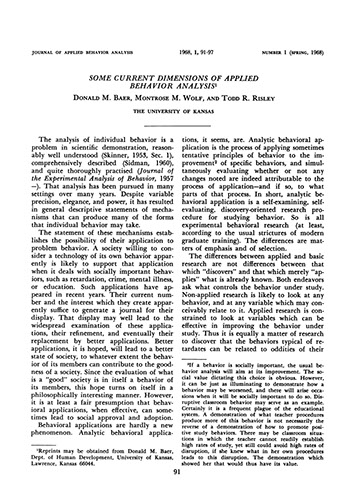

Home • Conference • News • Resources • Science • History • Autism • Bookshelf • Membership • Contact Us
Seven Dimensions of Applied Behavior Analysis
The seven dimensions of applied behavior analysis were introduced by Donald M. Baer, Montrose M. Wolf, and Todd R. Risley in their seminal article, "Some Current Dimensions of Applied Behavior Analysis," published in the inaugural issue of the Journal of Applied Behavior Analysis (Spring, 1968).
These dimensions describe the fundamental characteristics of any good applied intervention, carefully distinguishing application from experimental or conceptual analysis of behavior. These dimensions can also be used to guide formative analyses of applied behavioral treatments. That is, treatments that do not feature all seven dimensions are incomplete and potentially compromised in effectiveness. All page references are to the original article:
Baer, D.M., Wolf, M.M., & Risley, T.R. (1968). Some current dimensions of applied behavior analysis. Journal of Applied Behavior Analysis, 1, 91-97. (full text, pdf)
Summary Version
• Applied: Applied interventions deal with problems of demonstrated social importance.
• Behavioral: Applied interventions deal with measurable behavior (or reports if they can be validated).
• Analytic: Applied interventions require an objective demonstration that the procedures caused the effect.
• Technological: Applied interventions are described well enough that they can be implemented by anyone with training and resources.
• Conceptual Systems: Applied interventions arise from a specific and identifiable theoretical base rather than being a set of packages or tricks.
• Effective: Applied interventions produce strong, socially important effects.
• Generality: Applied interventions are designed from the outset to operate in new environments and continue after the formal treatments have ended.
Detailed Version
(Quotes from original text of article)
Applied: The label applied is not determined by the research procedures used but by the interest which society shows in the problems being studied. In behavioral application, the behavior, stimuli, and/or organism under study are chosen because of their importance to man and society, rather than their importance to theory. (p. 92)
Behavioral: Behaviorism and pragmatism seem often to go hand in hand. Applied research is eminently pragmatic; it asks how it is possible to get an individual to do something effectively. Thus it usually studies what subjects can be brought to do rather than what they can be brought to say; unless, of course, a verbal response is the behavior of interest. Accordingly a subject's verbal description of his own non-verbal behavior usually would not be accepted as a measure of his actual behavior unless it were independently substantiated. (p. 92)
Analytic: The analysis of a behavior, as the term is used here, requires a believable demonstration of the events that can be responsible for the occurrence or non-occurrence of that behavior. An experimenter has achieved an analysis of a behavior when he can exercise control over it. By common laboratory standards, that has meant an ability of the experimenter to turn the behavior on and off, or up and down, at will. (pp. 93-94)
Technological: "Technological" here means simply that the techniques making up a particular behavioral application are completely identified and described. In this sense, "play therapy" is not a technological description, nor is "social reinforcement". For purposes of application, all the salient ingredients of play therapy must be described as a set of contingencies between child response, therapist response, and play materials, before a statement of technique has been approached. Similarly, all the ingredients of social reinforcement must be specified (stimuli, contingency, and schedule) to qualify as a technological procedure....The best rule of thumb for evaluating a procedure description as technological is probably to ask whether a typically trained reader could replicate that procedure well enough to produce the same results, given only a reading of the description. This is very much the same criterion applied to procedure descriptions in non-applied research, of course. (p. 95)
Conceptual Systems: The field of applied behavior analysis will probably advance best if the published descriptions of its procedures are not only precisely technological, but also strive for relevance to principle. To describe exactly how a preschool teacher will attend to jungle-gym climbing in a child frightened of heights is good technological description; but further to call it a social reinforcement procedure relates it to basic concepts of behavioral development. Similarly, to describe the exact sequence of color changes whereby a child is moved from a color discrimination to a form discrimination is good; to refer also to "fading" and "errorless discrimination" is better. In both cases, the total description is adequate for successful replication by the reader; and it also shows the reader how similar procedures may be derived from basic principles. This can have the effect of making a body of technology into a discipline rather than a collection of tricks. Collections of tricks historically have been difficult to expand systematically, and when they were extensive, difficult
to learn and teach. (p. 96).
Effective: If the application of behavioral techniques does not produce large enough effects for practical value, then application has failed. Non-applied research often may be extremely valuable when it produces small but reliable effects, in that these effects testify to the operation of some variable which in itself has great theoretical importance. In application, the theoretical importance of a variable is usually not at issue. Its practical importance, specifically its power in altering behavior enough to be socially important, is the essential criterion. (p.96)
Generality: A behavioral change may be said to have generality if it proves durable over time, if it appears in a wide variety of possible environments, or if it spreads to a wide variety of related behaviors. Thus, the improvement of articulation in a clinic setting will prove to have generality if it endures into the future after the clinic visits stop. (p. 96).
Behavior Analysis Association of Michigan, Department of Psychology, Eastern Michigan University, Ypsilanti, MI 48197

